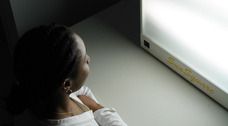 Sleep disturbances and behaviour problems, such as agitation or wandering, are common in patients with dementia―and in particular, in people with Alzheimer's disease. These disturbances can be attributed to "sundowning" (i.e. the disruption in the light/dark cycle caused by changes in the circadian rhythm).
Sleep disturbances and behaviour problems, such as agitation or wandering, are common in patients with dementia―and in particular, in people with Alzheimer's disease. These disturbances can be attributed to "sundowning" (i.e. the disruption in the light/dark cycle caused by changes in the circadian rhythm).
In patients with Alzheimer's disease, the circadian rhythm is less robust and less rhythmic than it is in cognitively-intact elderly people. Bright light is the strongest Zeitgeber (time cue) capable of synchronizing and stabilizing the circadian rhythm. The loss of the ability to process these environmental cues appears to be related to sleep disturbances in Alzheimer's disease.
A room equipped to simulate daylight
The Douglas Institute has a specially-equipped room in which light intensity can be controlled for a maximum of 2000 LUX of light, in order to simulate bright daylight. A research project is being designed to study the effect of light for a period of three weeks. The participants will be exposed to the light treatment each day, for two hours in late afternoon or during the evening. Different levels of intensity will be used, depending upon their capacity to tolerate this experience. During this time, sleep, restlessness and heart rhythms will be measured during each of the three shifts. The goal is to identify the most suitable light intensity and the timing for a given person, in order to normalize sleep patterns and/or control agitation. This treatment can then be transferred to the patient’s place of residence, using light therapy boxes.
A potential diagnostic tool to treat Alzheimer's Disease
In healthy elderly people and in patients with varying severity of dementia, the same technique can also be used to assess the sensitivity of the circadian system to external cues. This sensitivity can be measured through changes in the level of the hormone melatonin through exposure to different levels of light. If, by exposing people to low and mid ranges of light intensity, we find that melatonin levels are low in patients with early Alzheimer's disease, it may be a potentially useful tool for diagnosing Alzheimer's disease in its early stages, when pharmacological treatment has the potential to be much more effective and useful than it is in the later stages.


